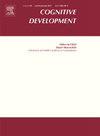Relationships between executive functions and morphosyntactic skills in Spanish-speaking children with and without developmental language disorder
IF 1.8
3区 心理学
Q3 PSYCHOLOGY, DEVELOPMENTAL
引用次数: 0
Abstract
One of the primary markers of developmental language disorder (DLD) is difficulties in the development of morphosyntax. In addition, because children with DLD often have deficits in executive functions (EFs) it has been suggested that EF may be associated with their reduced ability to comprehend and produce different morphosyntactic structures. However, the specific pattern of this relationship remains unclear. The present cross-sectional study examined the association of a set of EFs with the comprehension and production of morphosyntax in a sample of Spanish-speaking children with and without DLD. A total of 204 children aged 6–8 years were assessed: 105 with DLD and 99 with typical development (TD). Multiple regression models and path analyses were performed, with EFs as predictors and morphosyntactic comprehension and production as outcome or mediating variables. The results showed that in children with DLD the EFs of verbal working memory and cognitive flexibility were directly associated with morphosyntactic comprehension and indirectly with morphosyntactic production. This indirect relationship was mediated by morphosyntactic comprehension. In TD children, there was a significant relationship only between verbal working memory and morphosyntactic comprehension. These results suggest that school-aged children with DLD depend more on EFs for morphosyntactic processing than their TD peers. Furthermore, EFs have a more critical influence on morphosyntactic comprehension than production. Interventions aimed at improving morphosyntax in DLD should include EF activities.
有或无发展性语言障碍的西班牙语儿童执行功能与形态句法技能的关系
发展性语言障碍(DLD)的主要标志之一是形态语法发育困难。此外,由于患有DLD的儿童通常在执行功能(EFs)方面存在缺陷,因此有人认为EF可能与他们理解和产生不同形态句法结构的能力下降有关。然而,这种关系的具体模式尚不清楚。本横断面研究考察了一组有和没有DLD的说西班牙语的儿童的ef与理解和产生形态语法的关系。共有204名6-8岁的儿童被评估:105名患有DLD, 99名患有典型发育(TD)。以EFs为预测因子,形态句法理解和产生为结果或中介变量,进行了多元回归模型和路径分析。结果表明,言语工作记忆和认知灵活性与形态句法理解直接相关,与形态句法产生间接相关。这种间接关系是由形态句法理解介导的。在TD儿童中,只有言语工作记忆与形态句法理解之间存在显著的关系。这些结果表明,DLD的学龄儿童比TD的同龄人更依赖于电磁场进行形态句法加工。此外,电场对形态句法理解的影响比产生的影响更为关键。旨在改善DLD形态语法的干预措施应包括EF活动。
本文章由计算机程序翻译,如有差异,请以英文原文为准。
求助全文
约1分钟内获得全文
求助全文
来源期刊

Cognitive Development
Multiple-
CiteScore
3.20
自引率
5.60%
发文量
114
期刊介绍:
Cognitive Development contains the very best empirical and theoretical work on the development of perception, memory, language, concepts, thinking, problem solving, metacognition, and social cognition. Criteria for acceptance of articles will be: significance of the work to issues of current interest, substance of the argument, and clarity of expression. For purposes of publication in Cognitive Development, moral and social development will be considered part of cognitive development when they are related to the development of knowledge or thought processes.
 求助内容:
求助内容: 应助结果提醒方式:
应助结果提醒方式:


